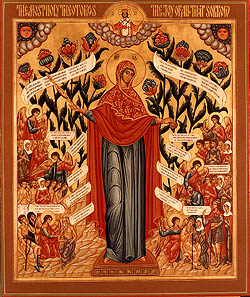Difference between revisions of "Mother of God Joy of All Who Sorrow"
m (→External links) |
m (→See also) |
||
| Line 35: | Line 35: | ||
==See also== | ==See also== | ||
* Her icons that have names like [[Mother of God Joy of All Who Sorrow|“The Joy of All who Sorrow”]] (“Vsekh Skorbiashchikh Radost”), [[Assuage My Sorrows|“Ease my Sorrows”]] (“Utoli moia pechali”), “Intercessor of Sinners” (“Sporuchnitsa greshnykh”), “Comfort in Griefs and Sorrows” (“V skorbiakh i Pechaliakh Uteshenie”). | * Her icons that have names like [[Mother of God Joy of All Who Sorrow|“The Joy of All who Sorrow”]] (“Vsekh Skorbiashchikh Radost”), [[Assuage My Sorrows|“Ease my Sorrows”]] (“Utoli moia pechali”), “Intercessor of Sinners” (“Sporuchnitsa greshnykh”), “Comfort in Griefs and Sorrows” (“V skorbiakh i Pechaliakh Uteshenie”). | ||
| + | |||
| + | * [[Softener of Hearts icon]] | ||
==External links== | ==External links== | ||
Revision as of 00:50, June 15, 2009
Mother of God, Joy of All Who Sorrow is the name of at least three well-known wonderworking icons of similar design.
On October 24, the Church commemorates the icon of the Mother of God, Joy of All Who Sorrow of Moscow. A woman named Euphymia (sister of Patriarch Joachim) received healing from sickness after obeying a voice telling her to find this icon and have the priest celebrate a Molieben with blessing of water. This miracle occurred on October 24, 1688.
On July 23, the Church commemorates the icon of the Mother of God, Joy of All Who Sorrow of St. Petersburg. This icon was glorified in 1888 when the chapel it was located in was struck by lightning. Miraculously, this icon survived despite all else being burned, and twelve coins from the poor box became attached to the icon.
On November 19, a third icon of similar name and design is commemorated.
There is also an akathist to the Theotokos, Joy of All Who Sorrow.
Icon's Design
The design of this icon depicts the Theotokos, a most beautiful blossom of heaven, standing among the flowers of paradise. Her Son is visible above her in the clouds, the King of heaven and earth. Along both sides of the icon, framing the Mother of God, are suppliants (us), asking for her intercession. She stands with her arms spread open and her head tilted as if listening. The tenderness and kindness of a loving mother are evident in her face. She stands in paradise and yet among us.
Icon's Theology
The theology in this icon depicts the Theotokos as also being our mother, who feels our pain. It is believed, by Orthodox Christians, that she intercedes for us, bringing our pain into her Son's presence. She is praying our prayers with love, bringing our needs into the unique relationship that a mother shares with her children.
She is our joy, because in her love she hears us. Her unceasing intercession and her limitless love help heal our sorrows.
Hymns
Troparion of the Icon (Tone 4)
- Let us the sinful and unworthy fervently run to the Mother of God
- And fall down crying in repentance from the depths of our souls:
- Help us, O Lady who hast had mercy on us.
- Hasten, for we perish from a multitude of sins.
- Turn not thy servants empty away, for we have thee as our only hope.
Kontakion of the Icon (Tone 6)
- We have no other help, we have no other hope,
- Apart from thee, O Lady.
- Come to our help. We hope in thee
- And in thee we glory.
- Let us not be confounded,
- For we are thy servants.
See also
- Her icons that have names like “The Joy of All who Sorrow” (“Vsekh Skorbiashchikh Radost”), “Ease my Sorrows” (“Utoli moia pechali”), “Intercessor of Sinners” (“Sporuchnitsa greshnykh”), “Comfort in Griefs and Sorrows” (“V skorbiakh i Pechaliakh Uteshenie”).
External links
- Icon of the Mother of God "the Joy of All Who Sorrow" in Moscow (October 24)
- An account of the story behind the icon commemorated on October 24, from the Prologue of Ohrid.
- Icon of the Mother of God "the Joy of All who Sorrow" (with coins) in St. Petersburg (July 23)
- Icon of the Mother of God "the Joy of All who Sorrow" (November 19)
- Akathist to the Theotokos, Joy of All Who Sorrow
- Notre Dame Joie des Affligés (french)
Categories > Arts
Categories > Arts
Categories > Church Life > Theotokonymia
Categories > Church Life > Theotokonymia > Icons of the Theotokos
Categories > Images > Icons
Categories > Liturgics > About Icons
Categories > Liturgics > About Icons
Categories > Liturgics > Feasts
Categories > Liturgics > Feasts
